- Direct from the grower
- Freshly shipped
- Fast delivery & collection point
- Spicy support

Spain is a country with diverse landscapes and a vibrant culture, and this is reflected in its cuisine. Spanish cuisine is a celebration of bold and rich flavours with fresh ingredients.
It is also described as a market cuisine. Whatever is sold at the market is used. So many of the products used are local and seasonal. From the agricultural fields and greenhouses in Andalusia to the freshly caught fish and seafood along the coast, each region has its own unique flavours and specialities. Olive oil, garlic, tomatoes and peppers are key ingredients that form the basis of many Spanish dishes.
Whether you enjoy tapas, paella or a sweet dessert, the flavours of Spain will take you to a world of culinary highlights.
Spanish cuisine can again be divided into several regional cuisines. On the menu of a restaurant in Andalusia, you will find different dishes than in Catalonia or the Basque country. Especially in central Spain, they eat heavier dishes such as a hearty bean or potato stew with meat and sausage. On the coast, meals are lighter and they use a lot of ingredients like fish, rice and vegetables. Because of these regional differences, it is a very varied cuisine. Below, the Andalusian and Basque cuisines are explained in more detail.
Andalusian cuisine
Andalusia is Spain’s most southern region. It is known for its many freshly grown products on agricultural land/fields. The warm Mediterranean climate provides an excess of olives, citrus fruits, almonds and various seasonal vegetables. These ingredients form the basis of many Andalusian dishes such as ajo blanco (almond and garlic soup) and ensalada malagueña (Malaga-style salad). A touch of Moorish influences can also be found in the cuisine. This is because the Moors ruled the region for centuries. They introduced exotic spices such as cumin, saffron and cinnamon. These spices give a unique and aromatic character to dishes like arroz con pollo (rice with chicken) and albóndigas (meatballs in sauce). Other well-known Andalusian dishes include gazpacho (a refreshing cold soup based on tomatoes, cucumbers, peppers and garlic), gambas al ajillo (garlic prawns) and pescaíto frito (fried fish).
Basque cuisine
The Basque country is located in the northern region of Spain. Because it located in the mountains and by the sea, both land and sea products are widely used. The sea provides plenty of fresh seafood, including hake, cod, anchovies and shellfish. These ingredients are reflected in a well-known Basque dish, Marmitako (hearty fish stew). But meat also plays an important role, with tender cuts of beef, pork and lamb. The famous chuletón (txuletón), a thick and perfectly grilled steak, is a proof of the Basque love for excellent meat. Pincho (Pintxos), the Basque version of tapas, is a well-known culinary tradition in the region. They are called pinchos because many of them have a pincho (Spanish for spike), typically a toothpick, or a skewer for the larger varieties, through them. Other well-known Basque dishes include piperade (tomato-pepper pot served with egg and ham), bakalao al pil-pil (cod with hot pepper sauce) and axoa (a veal stew with herbs, peppers and onions).
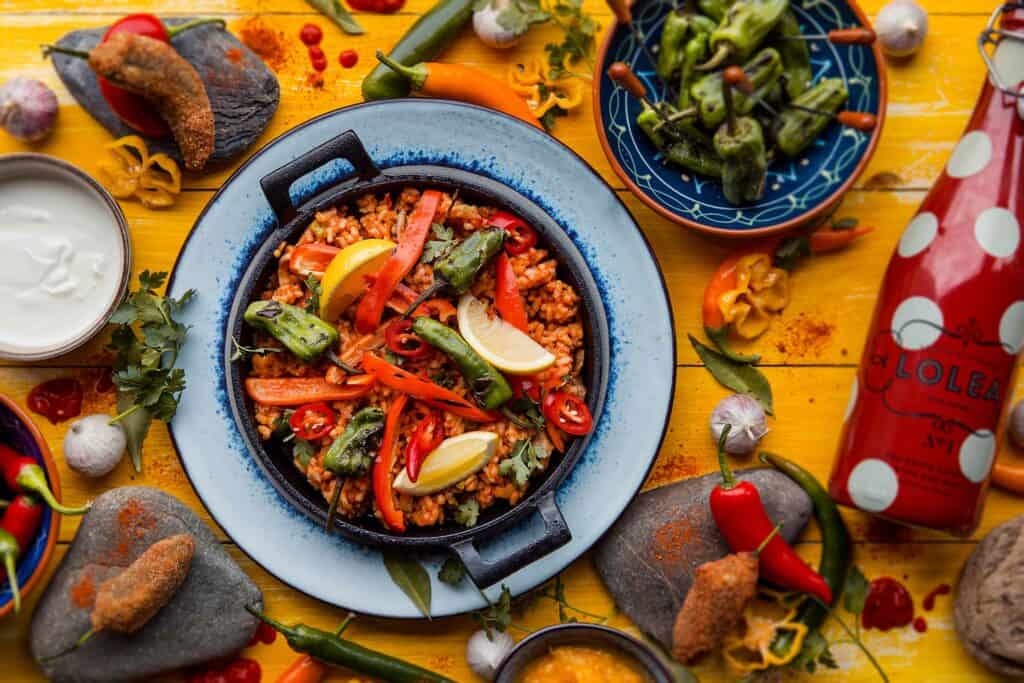

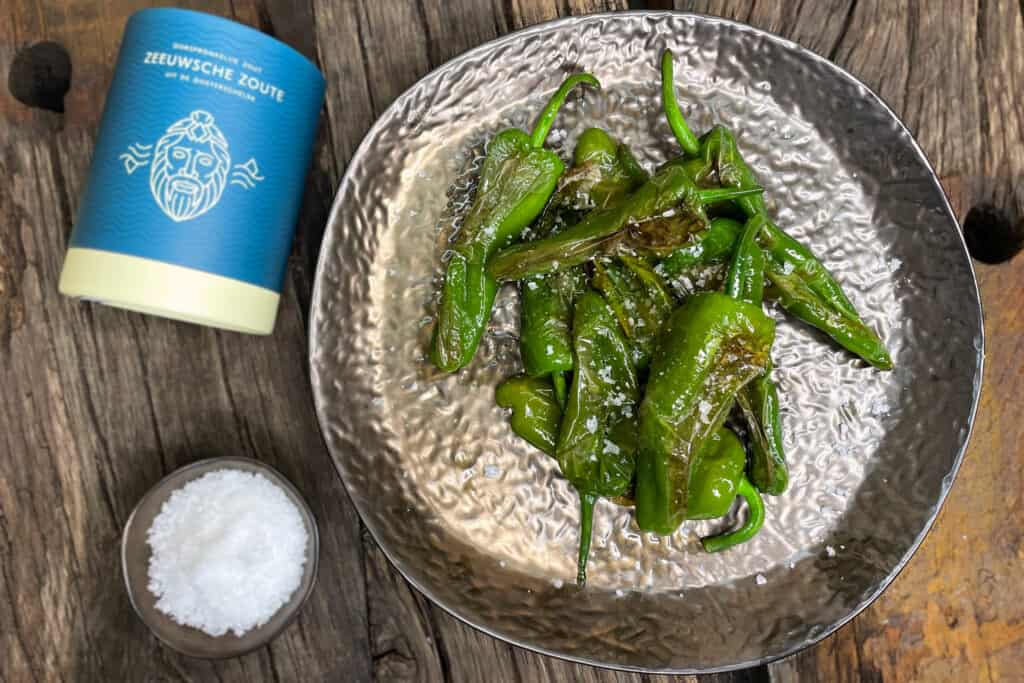

Chili peppers, called “pimientos” in Spanish, are essential in Spanish cuisine and often a key ingredient in several traditional dishes. They contribute to the complexity and depth of flavour of Spanish dishes. Whether adding a touch of heat to tapas, seasoning stews or adding a smoky flavour to sauces; chili peppers play an essential role in vibrant Spanish cuisine!
One of the best-known Spanish chilies is the Pimientos de Padron. The small green tapas peppers are usually fried or grilled in olive oil and sprinkled with sea salt. The mild chilies have a delicious slightly bitter and sometimes spicy flavour. It is a popular tapas dish.
The ‘normal’ pepper red, which we also call Spanish chili pepper in the Netherlands, is despide it’s name not originally from Spain, but from Central and South America. The prefix ‘Spanish’ originated when chili peppers were brought to Europe from America through Spanish traders in the 16th century. Spanish pepper, chili red, Lombok, Cayenne, are all different names for the same pepper and is used worldwide to flavour dishes, including in Spain.
Spanish cuisine also includes dried chili peppers, such as the Ñora pepper. These small, round peppers are sun-dried to develop a more intense sweetness. This dark red pepper adds flavour to many Spanish dishes and is an essential ingredient in a Romesco sauce and in many other sauces. This dried Ñora is used to make your own smoked sweet paprika (pimientón). This bell pepper cannot be compared to the bell pepper you find in the supermarket, as the Ñora pepper provides a deep smoky flavour. It is also an indispensable product in Spanish chorizo sausage and various tapas dishes.
Another popular dried chili is the “guindilla”, which is also used to make a chili pepper string. These mildly spicy chilies are also often pickled and served with dishes such as pintxos. Or are used to flavour sauces. They add a slightly spicy and slightly smoky touch to a dish.
Spain is also the land of many agricultural fields. All sorts of crops are grown there, including our chili peppers and bell peppers during the winter months (October-April). For years, Westlandpeppers has been working with the same growers in Spain who grow specially for us. There, they grow the same varieties of chili peppers that we have here in the summer season, such as the Habanero, Pimientos de Padron, Aji Amarillos and also the snack peppers. So we can offer products year-round. They are also Global GAP, GRASP & PlanetProof certified. With this, they are exceeding the strict requirements of supermarkets and PlanetProof. They grow in the Almeria region, which is also called the sea of plastic “mar de plástico”, this is not a real sea, but a super large area of about 30,000 hectares of plastic greenhouses. Today, the area constitutes the largest concentration of greenhouses in the world and 60% of Spain’s total horticultural production takes place in Almeria. Much of the European demand for fresh fruits and vegetables, such as tomatoes, peppers, cucumbers, courgettes, lettuce, melons are produced in Almeria.
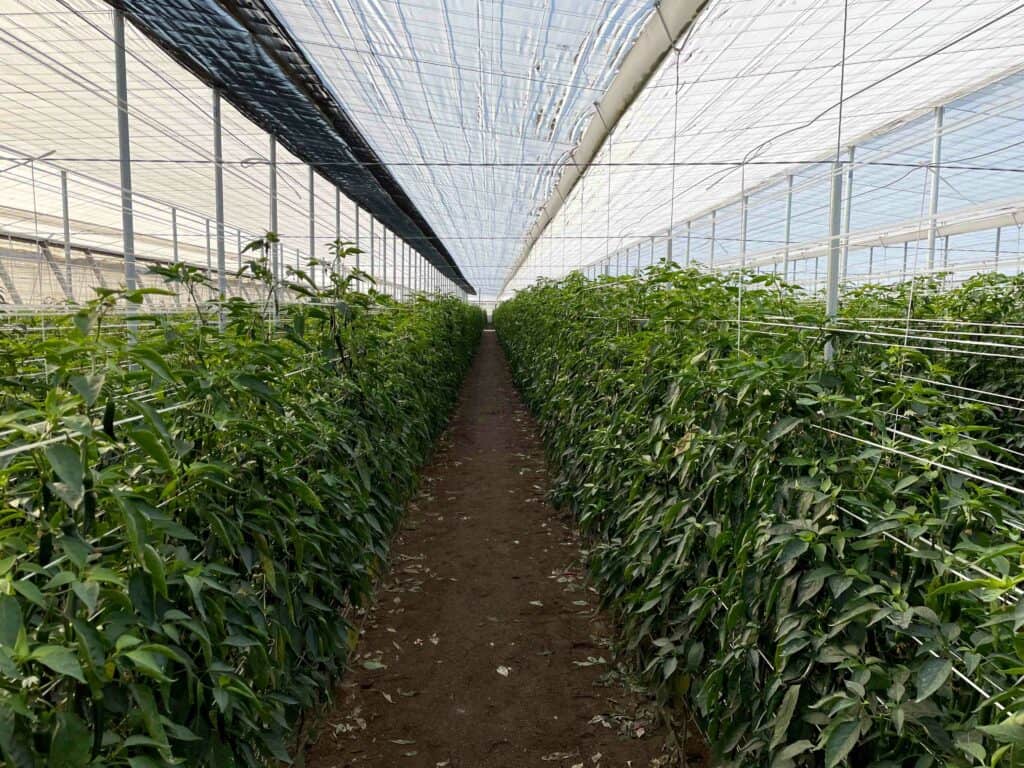
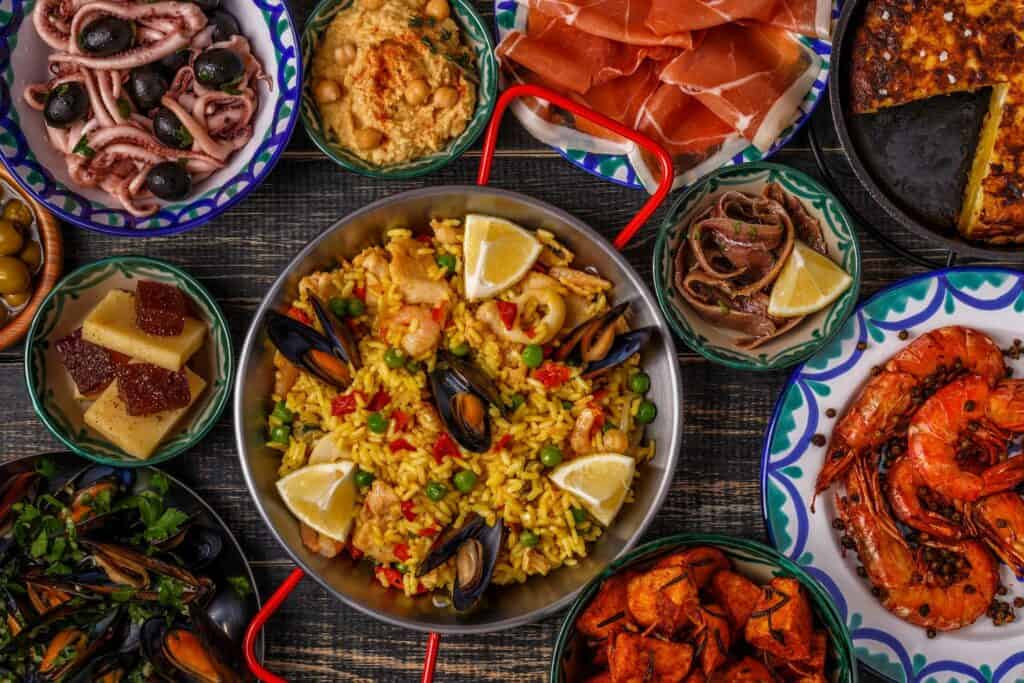
When people think of Spanish food, they often think of Tapas. The small plates with different snacks, are an important part of Spanish food culture. It makes it possible to eat together socially and share the dishes. These small bite-sized dishes range from classic favourites such as patatas bravas (spicy potatoes) and grilled Pimientos de Padron peppers to more complex preparations such as tortilla española (potato omelette), Jalapeño poppers (deep-fried and stuffed jalapeño peppers) and empanadas (stuffed dough pastry).
You can’t talk about Spanish cuisine without mentioning paella. This rice-based dish originates from the Valencia region, but is eaten all over the country. Traditional paella consists of rice, saffron, vegetables and various additions such as chicken, rabbit or seafood. The rice is cooked slowly, allowing the flavours to mix and be absorbed into the rice, giving paella a delicious aroma with deep and rich flavour.
Spain is also famous for its charcuterie / meats, especially jamón ibérico. This delicacy comes from black Iberian pigs fed on acorns and carefully aged for months or even years after slaughtering, resulting in a tender, marbled texture and a nutty, savoury taste. Its authentic flavour is due to the type of pig, but more importantly to its outdoor knitting and maturation. The leg of jamón ibérico is sliced thinly in a ham clamp with a razor-sharp knife.
Real jamón ibérico is very pricey, fortunately there are more affordable alternatives such as jamón serrano. This comes from white pig breeds. The ham is thicker and less marbled than ibérico ham and the leg shorter. Due to the shorter and less rich diet, the fat is white, harder and less supple. Serrano ham smells sweet, has a pronounced umami flavour and is saltier in flavour than ibérico ham.
Spanish dried sausages are also known all over the world, such as chorizo and salchichon. Chorizo comes in two varieties, picante (spicy) and dulce (sweet). This spicy or sweet flavour comes from the addition of dried and smoked, red bell pepper powder and chili powder (for picante).
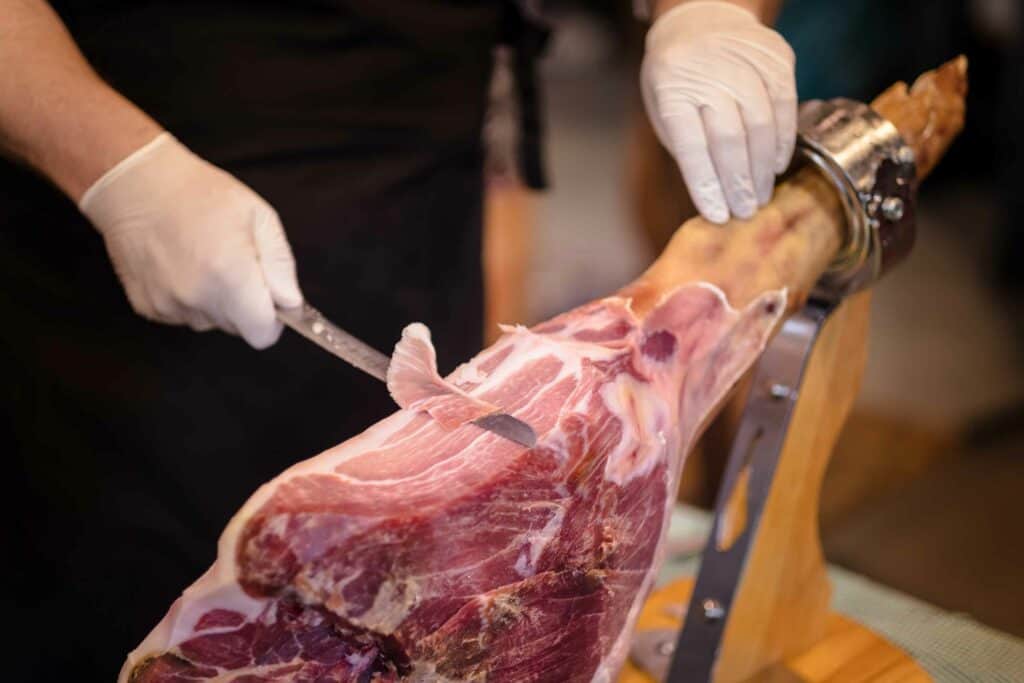
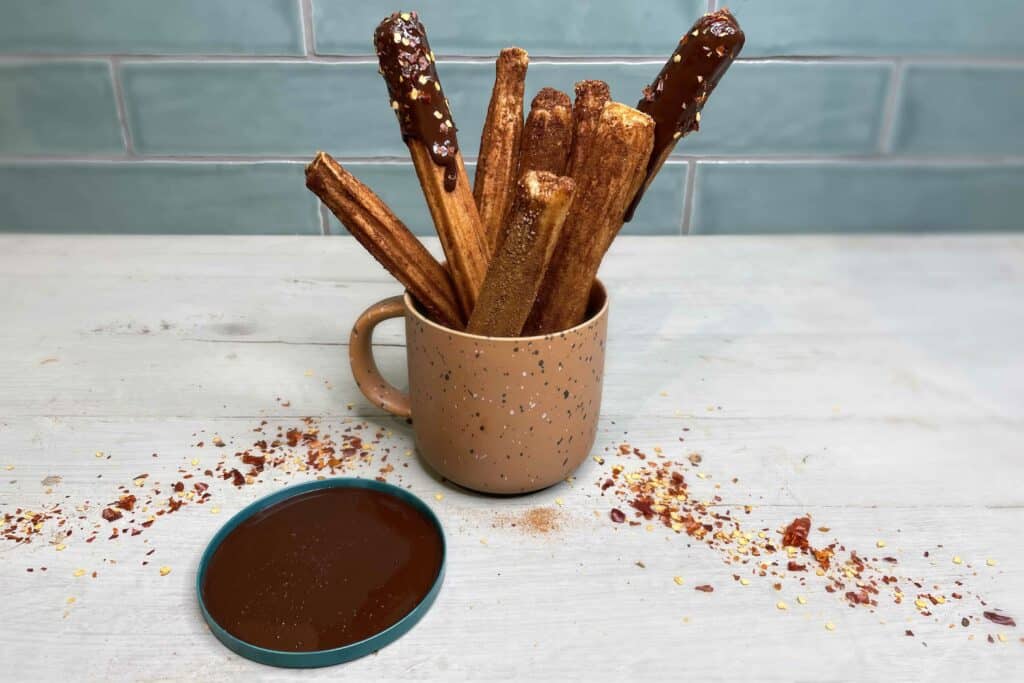
When it comes to desserts, Spanish cuisine offers several sweet options. Churros, deep-fried strings of dough sprinkled with cinnamon sugar or for a spicy version with chili flakes, are a favourite snack that can be enjoyed at any time of the day. Crema Catalana, a creamy custard dessert with a topping of caramelised sugar, and Tarta de Santiago, an almond cake from Galicia, are other popular desserts that will exite you.
One of Spain’s most characteristic drinks is Sangria, a refreshing and fruity drink. Sangria refers to sangre, which means blood, making it a blood-red drink. Although white Sangria also exists, a Spanish red wine, such as rioja or tempranillo, is usually chosen. This is mixed with sparkling water, pieces of fruit, such as oranges, apples, lemons, and further flavoured with triple sec, cointreau, brandy or cognac and sugar. It is the perfect choice for a hot summer day. Its vibrant colour and light, fruity flavours make it a favourite among locals and tourists. A lighter alternative to Sangria is Tinto de Verano. Here, the wine is mixed with a lime lemonade, sparkling water or soft drink.
Wine
Spain is the country with the largest area of wine-growing land in the world. It has an impressive selection of wines, including Rioja, Ribera del Duero, Sherry, Tempranillo and Priorat. From fruity and refreshing white wines to powerful and rich reds, Spanish wines are a perfect match for the country’s robust cuisine. Not surprisingly, dishes are often served with a glass of good Spanish wine and it has a central place in Spanish culture.

| Monday | 8:00 - 12:15 | 13:15 - 17:00 |
|---|---|---|
| Tuesday | 8:00 - 12:15 | 13:15 - 17:00 |
| Wednesday | 8:00 - 12:15 | 13:15 - 17:00 |
| Thursday | 8:00 - 12:15 | 13:15 - 17:00 |
| Friday | 8:00 - 12:15 | 13:15 - 17:00 |
| Saturday | 8:00 - 12:00 | |
| Sunday | Closed |
© Westlandpeppers | Webshop by Buro Staal